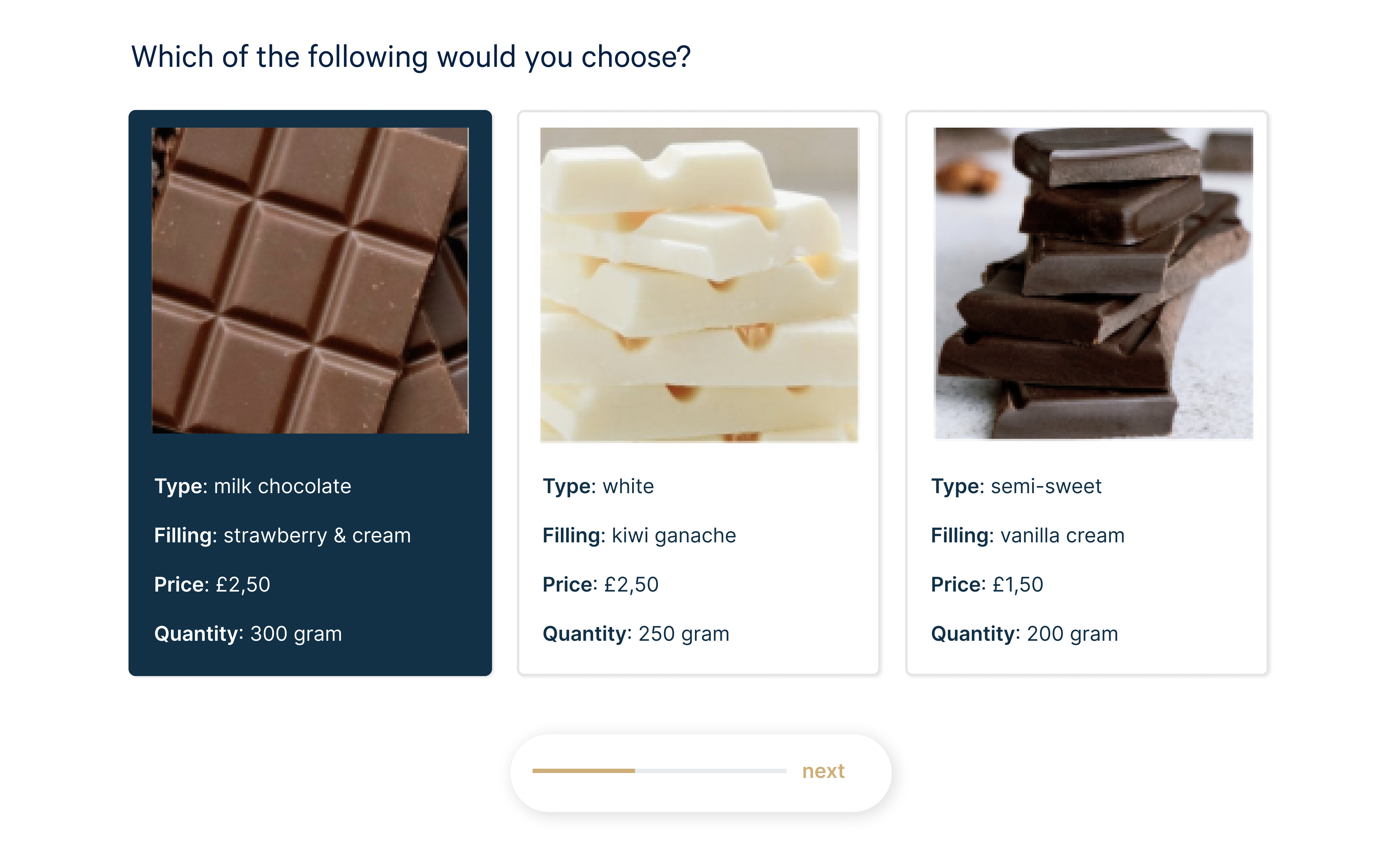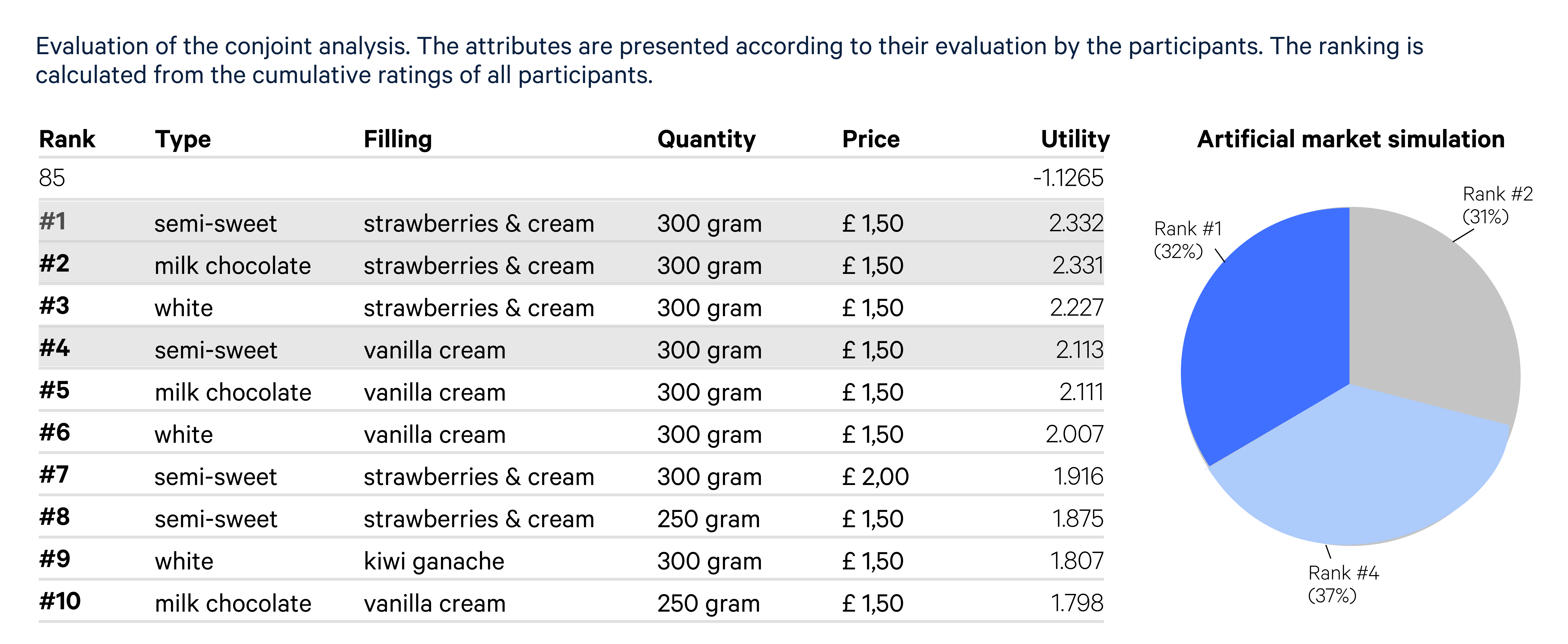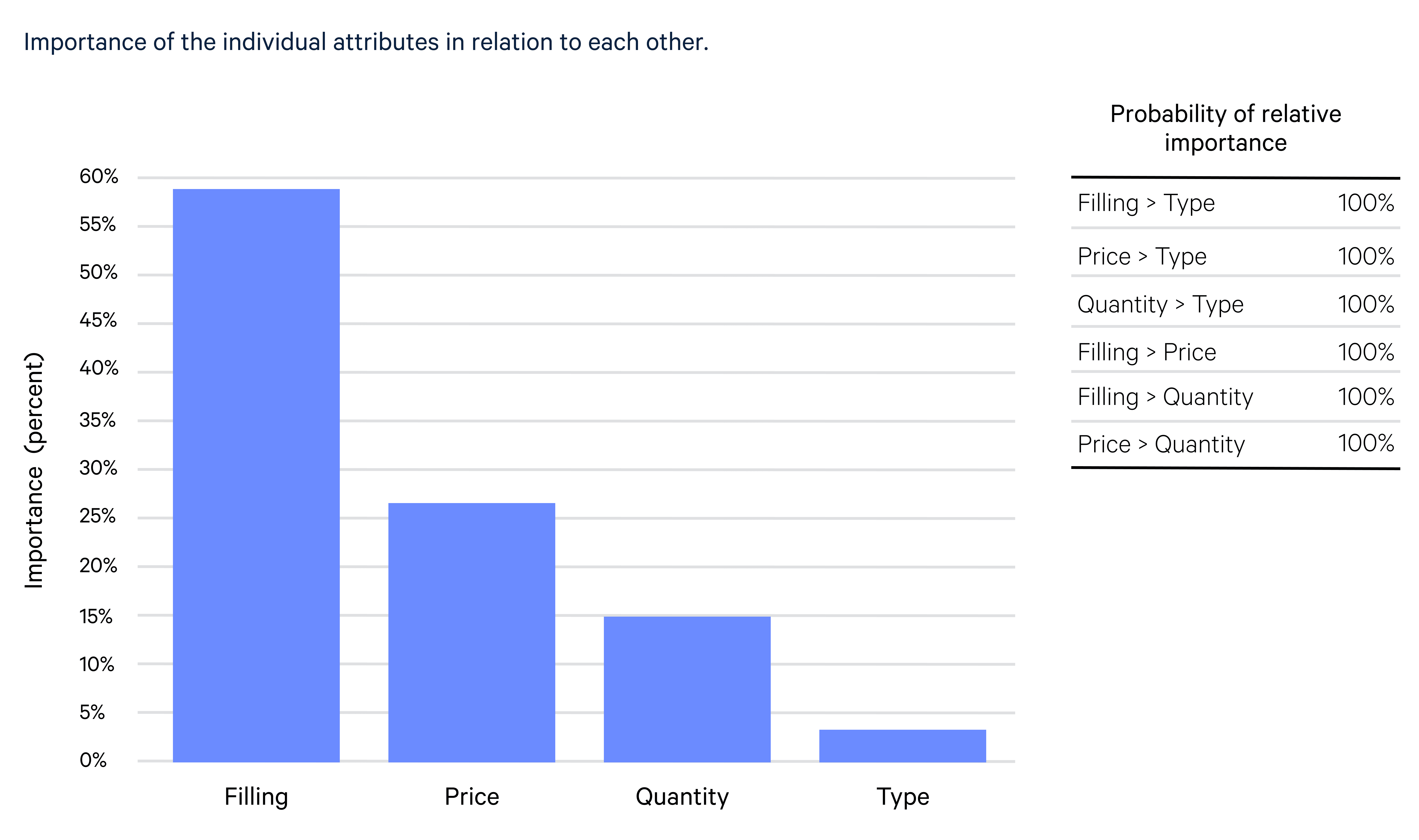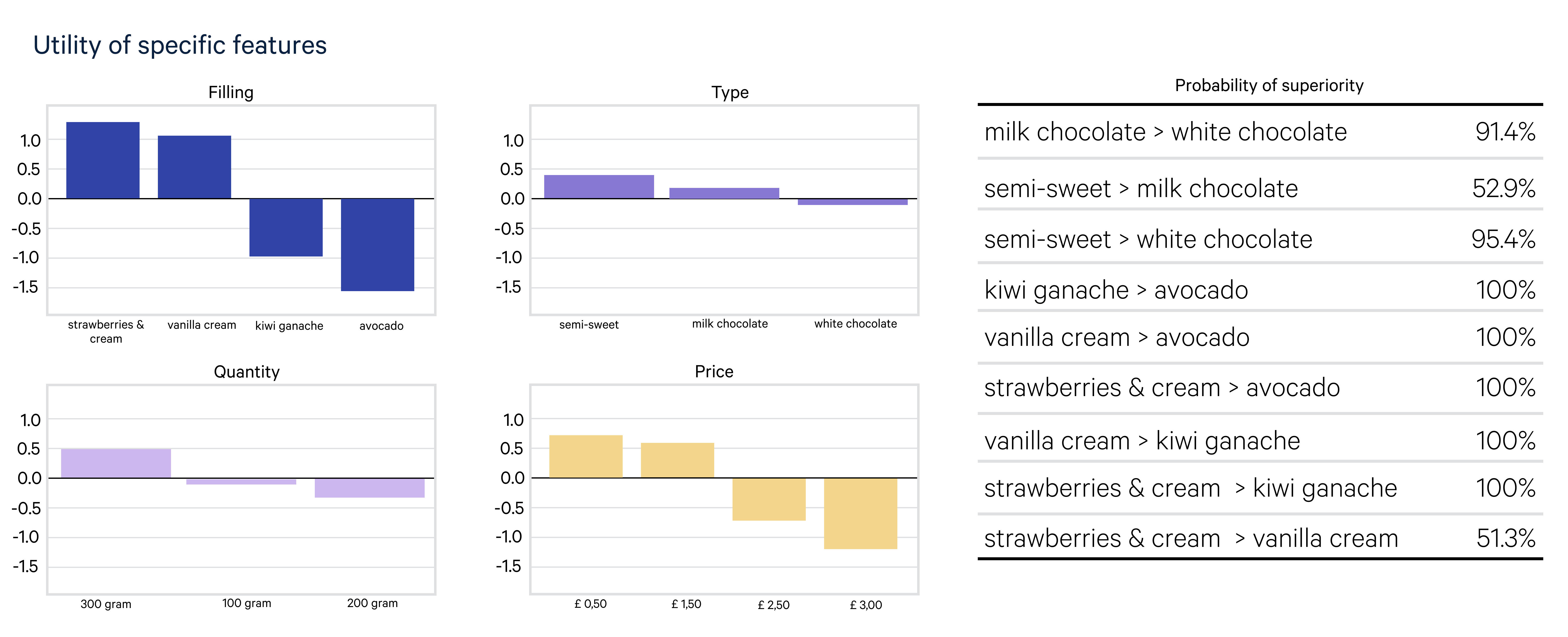Conjoint Analysis: a comprehensive practical guide
Appinio Research · 20.10.2022 · 13min read

Content
Product development and market establishment pose significant challenges for many companies.
During the development process, the central questions are: What features do customers expect, and which ones are the most important?
Unfortunately, approximately 95% of new product launches fail because they do not meet customers' requirements, expectations, or needs.
Therefore, it's crucial to conduct research to answer these questions and avoid potential failures.
Fortunately, these questions can be answered during the development phase with the help of a conjoint analysis.
In this article we'll explore how you can leverage the power of the conjoint analysis enabling the prediction of potential consumers' behavior in advance by presenting realistic purchase scenarios to identify gaps in existing product competition.
What is the conjoint analysis?
The term conjoint comes from a combination of "considered" and "jointly," which also defines the conjoint analysis. It involves considering various product features (attributes) together and weighing them against other variants.
The Conjoint analysis originated in psychology and was developed by Robert Luce and John Tukey in 1964.
Since then, it has primarily been used in market research and product development to determine what attributes consumers want and perceive as particularly important during the development stage.
Attributes can include functions, designs, or features such as weight, size, and price. However, because consumers tend to want as many attributes as possible for the lowest cost, conjoint analysis takes a different approach from methods such as the MaxDiff Method.
The distinctive feature of the conjoint method is the combination of different attributes instead of independent comparison.
This makes it useful for high-priced products like automobiles, hardware such as laptops or smartphones, luxury goods, as well as everyday products or during the conception phase.
The concept of the analysis is simple.
Consumers are shown different products that differ in the combination of features.
This creates a realistic experience that closely mimics an everyday purchase decision.
For example, in a conjoint analysis to determine consumer preferences for types of chocolate, the filling attribute might be divided into levels such as vanilla cream, strawberries & cream, and kiwi ganache.

In this sample conjoint analysis, the aim is to determine which types of chocolate consumers prefer and what price they are willing to pay for each type.
The respective attributes are leveled, i.e. they are displayed in a certain form. For the chocolate example the filling attribute is divided into the levels vanilla cream, strawberries & cream and, kiwi ganache.
Using this approach, a ranking can be created that shows which attributes are most important and which characteristics are most attractive.
This evaluation can then be used to decide on the most appealing and profitable combination for both consumers and the company.

What is the difference between the conjoint method and Discrete Choice Model?
While there are some similarities between the Conjoint analysis and the Discrete Choice Model (DCM), there are also some notable differences.
Both models are preference-structured and designed to uncover the factors that influence consumption choices.
However, the key difference lies in how respondents view the product profiles and their attributes.
In a Conjoint analysis, respondents view the product profiles in smaller groups, while in a DCM, they see all the products simultaneously.
This makes the DCM a bit more realistic in predicting buyer behavior than the Conjoint analysis.
However, it can also be overwhelming for respondents as they are presented with a large number of options.
One of the advantages of the Conjoint analysis is that it provides more information about the attributes' relativity and importance to each other, as well as their contribution to the final buying decision. This is not possible with the DCM.
Moreover, the Conjoint analysis is an excellent tool for predicting behavior before the product is launched, which is less likely when using a DCM.
The Choice-Based conjoint method
The Choice-Based conjoint analysis (CBC) is the most popular form of conjoint analysis and for good reason.
Unlike other forms, CBC analysis asks consumers to make decisions between product variants and accept trade-offs, resulting in a more detailed and realistic analysis.
This approach reflects the fact that we make numerous decisions daily where we weigh different attributes against each other.
In CBC analysis, all previously defined attributes are combined evenly to create a statistically valid ranking at the end of the analysis.
Although there are other types of conjoint analysis, such as the Adaptive Choice conjoint and the Menu-Based conjoint analysis, they are not as flexible as the CBC method and cannot be used as widely.
At Appinio, we specialize in CBC analysis and can help you gain valuable insights into consumer preferences and behavior.
Use cases for Conjoint Analysis
The conjoint analysis is a versatile market research method suitable for a variety of use cases. Three common applications of conjoint analysis are:
-
Concept testing
Conjoint analysis is useful for testing product concepts in the early stages of development.
By identifying consumer preferences and potential flaws early on, resources can be saved and the risk of a failed product launch can be minimized. -
Diversification and product range expansion
The conjoint method is also helpful for testing new product variants, such as different sizes, flavors, or colors, and for optimizing the product range. -
Price determination
The conjoint analysis can be used to determine the optimal price for a product or service.
It can be used as a stand-alone method or in combination with other price analysis techniques like Van Westendorp price analysis.
By testing different concepts for their willingness to pay, businesses can make informed pricing decisions.
Research experts answer: When exactly should a Conjoint Analysis be conducted?
Conduct a Conjoint Analysis when expanding into new markets, launching new products, or optimizing existing ones. It provides detailed insights into customer preferences and trade-offs, ensuring your offerings meet market demands.
Conjoint Analysis' best practices
When conducting a conjoint analysis, it is important to follow best practices in order to ensure accurate results.
Here are some tips to keep in mind:
- Use short and concise descriptions of product features to avoid misunderstandings that could distort the analysis.
- Use pictures to help respondents distinguish between different variants and imagine the products being tested.
- Use descriptive comparisons for attributes rather than abstract levels such as "light" or "heavy". Concrete comparisons, such as "as heavy as a similar product," are more appropriate.
To make implementation of these tips easier, consider using the Appinio Conjoint Analysis Tool. This tool provides the necessary setting options for a successful conjoint analysis.
Book a demo and our experts will support all your research needs.
Setting up a conjoint analysis (with Appinio)
Conducting a Conjoint analysis with Appinio couldn't be easier.
Step 1: Get the survey ready
-
Register on the Appinio platform.
-
Define the 3-4 most important product features (e.g. price, design) to be tested.
-
Contact one of our market research experts. They will guide you with formulating the definition of the product features right up until your survey goes live.
Step 2: Send your survey live
- Our research consultants will do a final check before your survey goes live.
- See the answers coming in! Our panel responds as soon as the survey is live.
Step 3: Analyze your data
- Go to the Appinio interactive dashboard and start analyzing the data you collected.
- The results of the conjoint survey are calculated and visualised in bar graphs and tables by our research consultants to show the utilities and importance of each factor. Accordingly, the results can be used immediately for decision-making.
- Export your results to Excel, PPT or CSV at any time.


What are the advantages and disadvantages of a conjoint analysis?
Conjoint analysis offers several advantages and disadvantages that should be considered when implementing this research method.
Advantages
- Conjoint analysis can help determine which product features are necessary and which ones consumers would be willing to forgo.
- The analysis can measure subconscious decisions, thanks to the many different combinations of attributes and levels that can be included.
-
The research design is highly flexible and can be adapted to fit almost any product or concept.
-
The method is incredibly versatile, covering a wide range of studies such as price willingness, design tests, or product attributes.
Disadvantages
As with any research method, there are also potential disadvantages to consider when using conjoint analysis.
For example:
- Respondents may choose luxury variants since they are not actually spending any money and therefore have no sense of making a real purchasing decision. This can lead to a discrepancy between survey results and actual market behavior.
Conclusion for Conjoint Analysis
Conjoint analysis is a powerful market research tool that offers a multitude of advantages and can be used for a wide range of use cases, particularly in the areas of product development and marketing.
Its flexibility and ability to realistically reflect everyday purchase decisions make it an essential tool for businesses looking to develop and launch successful products.
With conjoint analysis, several combinations and variants can be tested without consumers having to choose their favorites from a list of attributes, allowing for a more accurate analysis of consumer preferences.
Overall, conjoint analysis is an effective way to make informed decisions about product development and marketing strategies, ultimately helping businesses to succeed in a competitive market.
Conjoint Analysis explained
-
Types of conjoint analysis include Choice-Based conjoint (CBC) analysis, Adaptive Choice conjoint and the Menu-Based conjoint analysis.
-
Below are basic steps in conducting a conjoint analysis: 1.) Determine a selection of 3-5 attributes (e.g., color, size, price, etc.), 2.) Ensure that each come with different characteristics (e.g., blue, green, yellow), 3.) Form randomly assembled sets that simulate product or service packages, 4.) Once done, participants must then decide between the different sets.
-
Main goals of conjoint analysis include using collected data to rank which attributes and characteristics are most attractive to consumers.
-
Conjoint analysis is a quantitative research method where respondents complete surveys featuring multiple product or concepts presented in choice sets.
-
Conjoint analysis is used in various industries, including market research, healthcare, technology, finance, and retail, to capture customer preferences and can predict real-world buying behavior.
Ready for your conjoint analysis study with Appinio?
In our dashboard, you will find a sample tracking and questionnaire templates that you can customize and get the insights you need to bring your brand to the next level.
Get facts and figures 🧠
Want to see more data insights? Our free reports are just the right thing for you!


